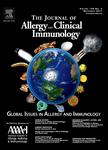版权所有:内蒙古大学图书馆 技术提供:维普资讯• 智图
内蒙古自治区呼和浩特市赛罕区大学西街235号 邮编: 010021

作者机构:CTR HEMODIALYSE LANGUEDOC MEDITERRANEEN MONTPELLIER FRANCE CLIN NEPHROL MONTPELLIER FRANCE
出 版 物:《JOURNAL OF ALLERGY AND CLINICAL IMMUNOLOGY》 (变态反应与临床免疫学杂志)
年 卷 期:1988年第81卷第3期
页 面:590-597页
核心收录:
学科分类:1002[医学-临床医学] 1001[医学-基础医学(可授医学、理学学位)] 100201[医学-内科学(含:心血管病、血液病、呼吸系病、消化系病、内分泌与代谢病、肾病、风湿病、传染病)] 10[医学]
摘 要:Maintenance hemodialysis is widely used throughout the world, and anaphylactic reactions appear to be increasing in number and severity. However, the exact incidence of sensitization and the role of atopy in these reactions are not yet fully understood. All of the 111 patients routinely dialyzed in a center were tested. All patients had a complete investigation of atopy, RAST to chemicals released during the procedure of dialysis (ethylene oxide (Eto), formaldehyde, phtalic anhydride, and toluene diisocyanate), skin tests with the effluent, and the titration of blood eosinophils. The incidence of atopy was found to be lower (13.5%) than in the normal population of the area. Skin tests with either histamine or allergens are significantly (p 0.001) smaller than those of nondialyzed subjects, and this method does not appear to be ideal in this population of patients. Eto sensitivity ranked first (5.5%), followed by phthalic anhydride sensitivity (3.6%);5/6 patients who had a sensitivity to Eto and/ or phthalic anhydride present symptoms during dialysis, but they never were life threatening. Formaldehyde RAST was only found in one patient who had a life-threatening reaction. Finally, three patients presenting pruritus had positive skin prick tests with the effluent of the dialyzer. All patients having a first use syndrome and 80/81 symptom-free patients did not have serum specific IgE against the released chemicals, 5/17 patients who had a pruritus during dialysis had either positive RAST to released chemicals or skin tests to the effluent, 5/8 patients who suffered from anaphylaxis had positive RAST to released chemicals, but only those who had a positive RAST presented a severe reaction. Atopy appeared to predispose to the development of allergy to released chemicals, since 40% of atopic individuals were sensitized to them. Total serum IgE was significantly (p 0.001) increased in allergic subjects. Blood eosinophils were significantly (p 0.01) increased in aller